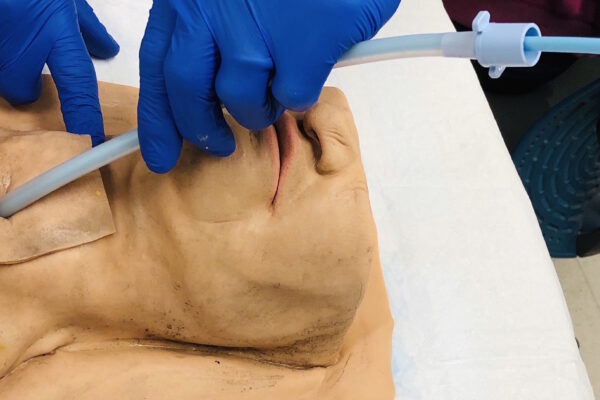If a patient’s airway is compromised during a life-threatening situation, prompt and effective intervention is crucial. This includes front-of-neck access (FONA) emergency airway, or cricothyroidotomy.
Also known as cricothyrotomy, it is a specialized procedure that creates emergency access to the airway when other conventional methods fail, or in situations where intubation and oxygenation aren’t options.
Emergency front-of-neck access (eFONA) can be helpful during drastic, life-or-death situations. Let’s learn more about this specialized procedure, including the four techniques you can use and its associated risks.
What Is an Emergency Airway Procedure?
An emergency front of neck access is a time-critical medical procedure. It is performed during “can’t intubate, can’t oxygenate” situations when facemasks, supraglottic airway devices, and tracheal tubes have failed to manage the airway effectively.
Typically performed when someone is choking, an emergency airway procedure can aid in breathing. It involves the insertion of a hollow needle or tube into the throat, just under the thyroid cartilage, between that and the cricoid cartilage. A small cut can be made in the membrane and skin between the two cartilages to aid in the insertion of the needle or tube.
What Are the Different Techniques Used To Perform FONA?
An emergency front-of-neck access procedure can be performed with the help of four different techniques:
Needle/Seldinger FONA
A needle/seldinger FONA is primarily performed in extreme emergency situations and acts as an interim measure when an open cricothyrotomy is not possible. It involves a vertical incision of at least 3 cm, made over the cricothyroid membrane (CTM). After this, a needle is inserted at an angle, and a wire is introduced. Then, the cannula is advanced with a pre-loaded dilator.
This aids healthcare providers in giving the patient conventional ventilation.
Some complications can arise in this procedure, such as:
- Pneumothorax
- Subcutaneous emphysema
- Mediastinal emphysema
- Bleeding
- Oesophageal puncture
- Respiratory acidosis caused by hypoventilation
- Complete upper airway obstruction
- Subglottic stenosis
The risk of injury to the vocal cord is also a possible complication. However, if administered properly by trained professionals, the risk is reduced.
Surgical FONA
A surgical FONA involves some amount of tissue dissection and is more technical in nature. It entails an incision made over the CTM, dissecting the tissue towards it. A tracheal hook can then be inserted through the incision to retract the thyroid or cricoid cartilage. A large-bore cricothyrotomy cannula is inserted and secured for the patient’s conventional ventilation.
The main complication in the surgical FONA method may be excessive bleeding. It can also cause scarring and require a longer healing period.
Scalpel-Bougie FONA
This technique has numerous minor variations depending on how the scalpel is used, and whether or not a tracheal hook is included in the procedure. It is faster than the cannula to Melker technique.
Though it can be performed in different ways, the procedure may involve steps such as dissecting the tissue horizontally to the CTM, inserting and retracting a tracheal hook, and inserting a bougie and endotracheal tube (ET) into the trachea.
Like other FONA methods, this method is done in an attempt to secure conventional ventilation for the patient.
Trans-tracheal Catheter FONA
This technique includes the placement of a trans-tracheal catheter by cannulating the trachea with gentle aspiration. After this, the transtracheal catheter is slowly inserted to deliver oxygen with the help of a jet ventilator, and oxygen flow modulator, or self-inflating bag.
Are There Any Risks Associated With FONA?
As is the case with any medical procedure, FONA is not a perfect solution. It has certain risks and side effects that include:
- Cephalad displacement of the intubation tube
- Injury to the voice box or larynx
- Tube obstruction caused by vomiting
- Tube kink
- Injury to the esophagus
- Cuff injury
- Bleeding and infection during incision
- Injury to the thyroid gland
In some cases, these risks can be mitigated or avoided with the right training to ensure that the procedure is performed with utmost precision and care.
How Can You Effectively Train To Perform FONA?
To ensure that FONA is performed safely and effectively, it is important to ensure that medical professionals undergo the right training and practice. Here are some ways to ensure that FONA is done precisely and correctly:
- Learn how to quickly and accurately identify the location of the cricothyroid membrane in a patient that is anesthetized through palpation.
- Become familiar with the contents and equipment of a FONA kit. Know how to quickly and efficiently use each tool.
- Practice regularly and perform simulations of the workflow regarding the preferred airway FONA technique.
- Practice the procedures involved in the transtracheal injection that is used for tracheal topical local anesthesia. This includes familiarizing yourself with a fiberoptic intubation preparation routine.
Airway management and FONA can be performed by non-surgeons with the right training and practice. As an effective and critical medical procedure, it is thus important that all healthcare providers are aware of how it can be done.
Final Thoughts
Emergency airway is a critical procedure that can save lives in potentially fatal situations. It can establish or secure the airway while preventing severe hypoxia and ensuring optimal oxygenation.
As an advanced procedure, it must be performed by trained healthcare professionals in high-risk situations. It is also important that proper procedures be followed and the appropriate next steps for long-term airway management are determined.
Resources
McLauchlan, C. Pidsley, R- Vandenberk, P. Minor trauma major problem. Neck injuries, retropharyngeal haematoma and emergency airway management. Case Report. 1991. 8. 135-139
Price, TM. McCoy, E.P. Emergency front of neck access in airway management. BJA Educ. 201; 19(8): 246–253.
Morton, S. Avery, P. Kua, J. O´Meara, M. Success rate of prehospital emergency front-of-neck access (FONA): a systematic review and meta-analysis. Br J Anaesth. 2023. ;130(5):636-644. doi: 10.1016

